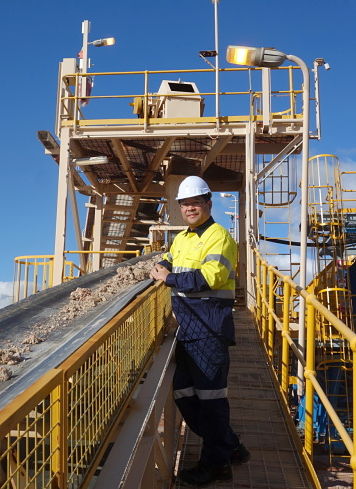 This article by Jennifer Tan (left, Director, Research & Products, Equities & Fixed Income, at the Singapore Exchange) was published in SGX's kopi-C: the Company brew series recently. The article is republished with permission.
This article by Jennifer Tan (left, Director, Research & Products, Equities & Fixed Income, at the Singapore Exchange) was published in SGX's kopi-C: the Company brew series recently. The article is republished with permission.
|
Tjandra Pramoko, the Chief Executive Officer of SGX-listed Alliance Mineral Assets Ltd, enjoys getting his hands dirty.
"Mining is my passion - I've been dealing with stones most of my life, and I love what I do," said the Bachelor of Business graduate from Edith Cowan University in Western Australia.
"Most people don't realise mining is actually very hard work - you need to be very hands-on."
Fresh out of university, Pramoko began helping out in the family business. "My father built one of the largest businesses in the stone industry during the early 90's by mining in Indonesia, and supplying the finished product in the form of marble and granite to the building and construction industry in Australia," he said. |
In early 2000, just before Australia entered the mining boom, prospects were bright and exploration grounds plentiful.
"We saw the rapid expansion of China's economy, and how the Chinese came to Western Australia and invested heavily in the mining sector," Pramoko said.
"With my economics background and construction industry experience, I was confident of venturing into mining. Our first foray involved buying a few mining sites and selling them to a major iron ore producer."
Pramoko continued to acquire mining assets and licenses, and bought the Bald Hill site in 2009. Together with his wife Simone Suen, he founded Alliance Mineral Assets Ltd in 2010 to do exploration and mining of Bald Hill.
Suen was named Executive Director of Alliance in 2010. In June 2014, Pramoko, who was then a consultant of the company, was appointed its CEO. In July that year, Alliance was listed on Singapore Exchange's Catalist board.
Tested to the Limit
The Bald Hill Project in Western Australia covers an area of 59,000 hectares, which is slightly smaller than the size of Singapore. Exploration activities began in the 1960s, and mining has been conducted since the 1970s. The project, which includes four mining leases, eight prospecting licenses and eight exploration licenses, started off by mining tantalum.
Tantalum is a rare, highly corrosion-resistant metal, widely used in automotive electronics, mobile phones, computers and surgical instruments. Australia is the second-largest global resource for the hard, blue-grey metal, which is considered a conflict mineral. The 2010 Dodd-Frank legislation in the US has led to a de-facto embargo on tantalum from the Democratic Republic of Congo.
More than a year after its listing, Alliance, which secured an offtake agreement with Mitsubishi Corporation RtM Japan, began producing tantalum. Shortly after, prices of the metal, which were hovering around US$85 per pound, started falling.
"We delivered our first shipment of tantalum in December 2015, and by February 2016, prices were tanking. By April, they had collapsed to US$55 per pound, and went as low as US$50 per pound," Pramoko recalled.
At those levels, the project could barely break even. "So, we made the difficult decision to stop our operations."
It was a big blow that later turned out to be a blessing.
"We were tested, very tested," he said. "But we continued to hope, because we knew our ore deposits were the best in the area."
Husband and wife went back to the drawing board. They sifted through old exploration data - mostly hand-drawn geological reports - of the mine site to see if they could find higher grade tantalum deposits to boost their economics of production. They carried out further metallurgical tests on by-products from recent extractions "to see if we had missed anything."
|
"If tantalum prices had not collapsed, we would not have found what we had. It was a learning curve we were meant to go through, and we're very blessed that we got the right address." |
That was when they hit the jackpot - studies showed that Bald Hill's most significant by-product was a 6.73% lithium oxide spodumene concentrate.
Lithium belongs to the group of alkali metals - the lightest of all metals and the least dense solid element. Demand for the soft, silvery white metal is driven by lithium-ion batteries used in electric vehicles, energy storage systems and mobile phones.
Spodumene is a lithium-bearing, aluminium silicate mineral occurring mostly in lithium-rich pegmatites, or granite-like igneous rock. Spodumene concentrate is converted to lithium carbonate through thermal processing and leaching methods.
Turnaround Story
The change in Alliance's fortunes has drawn significant investor attention. Last June, Lithco 2 - a subsidiary of Australian company Tawana Resources - agreed to partner Alliance for the exploration and exploitation of minerals in the Bald Hill Project, contributing A$20 million to earn its 50% share of the joint venture.
The amount comprises a minimum A$7.5 million spending on exploration, evaluation and feasibility by end-2017, as well as A$12.5 million for upgrading and converting the plant to process ore from the project by end-2019. Tawana's partnership also provides expert knowledge through its Managing Director Mark Calderwood, who has three decades of mineral exploration experience.
At the same time, the company successfully placed out 83.5 million new shares at 6 Singapore cents each to institutional investors, raising S$5 million.
Alliance has a current market capitalisation of more than S$130 million. Its shares have tripled in the year-to-date, surging 197% on 22 March 2017 to a fresh 52-week peak of 27 Singapore cents, its highest in nearly two-and-a-half years. This level is still 26% below the all-time high of 36.5 cents reached on its 25 July 2014 trading debut.
The company has yet to report revenue from production. Between the financial years ended 30 June 2014 and 2016, it averaged an annual net loss of A$7.1 million.
For the fiscal second quarter ended 31 December 2016, Alliance reported a loss after tax of A$989,360, compared with a net loss of A$678,245 in the year-earlier period. Cash and cash equivalents stood at A$3.3 million as at 31 December 2016, compared with A$5.4 million as at 30 June 2016.
Meanwhile, drilling work to test for lithium at Bald Hill is nearly complete, with the resource estimate likely to be released by early next month. The feasibility study is scheduled to be completed in five weeks, and Alliance aims to award engineering, procurement and construction contracts for mine infrastructure in the same time frame. Production is expected to commence before year-end.
|
|
Concurrently, it will finalise offtake agreements with the potential partners it has been in talks with, as well as review pre-payment and other financing opportunities.
Over 80% of global lithium supply comes from four major producers - Australia's Talison Lithium, Chile's SQM Lithium, as well as Albemarle Corp and FMC Corp, both US chemical companies. Apart from Talison, top lithium producers down under include Galaxy Resources Ltd and Neometals Ltd.
Riding the Uptrend
Last year's tight market for lithium is expected to extend into 2017, further boosting prices, Canaccord Genuity said in report published last December. Reported contract prices achieved in 2016 by key players, including Galaxy Resources, point to year-over-year price increases of around 50% for both lithium carbonate - at US$10,000-US$12,000 per tonne - and spodumene concentrate - at over US$850 per tonne, Canaccord data showed.
As a result, the research firm has raised its near-term projections - forecasting lithium carbonate prices of US$12,000 per tonne this year, up 60% year-on-year, and US$9,243 a tonne next year, up 32% year-over-year. For spodumene concentrate, it expects prices to rise 67% year-on-year to US$904 per tonne, and 55% year-over-year to US$745 a tonne, for 2017 and 2018 respectively.
Canaccord's longer term projections - for 2025 - remain mostly unchanged at US$10,300 a tonne and US$727 per tonne for carbonate and spodumene respectively.
The next few years will be an opportune time for Alliance to ride the uptrend in lithium prices, Pramoko said. "This is why we're rushing to take advantage of higher prices now. After that, when supplies increase, prices will fall."
|
"The cost of mining either tantalum or lithium is the same, but with one cost, we're getting two products. If we only had tantalum, we would be struggling." |
On top of revenue from hard-rock lithium production, Alliance will get "a healthy tantalum credit", as it intends to produce and sell tantalum from the same ore.
Tantalum prices are currently hovering around US$70 per pound, and are expected to return to 2013-2014 levels of US$100 per pound over the longer term. "That will boost our bottom line by another 25% to 28%," he said.
One way to weather price cycles in the mining industry is to establish strong customer relationships. "Once you have an established product, most Chinese and Japanese offtakers are focused on securing the supply," Pramoko said.
"They usually want only one source, because that supplier would have been qualified and meets all their specs. As long as they can get the product they want, they are willing to pay, and that helps to absorb the industry's price fluctuations over the longer term."
Another avenue of diversification is finding new lithium customers. "We will conduct a feasibility study to determine if our lithium is suitable for the ceramic and glass industry. Using lithium in cookware makes it more stable, so it doesn't crack or shatter under high temperatures," he added.
The upside for Bald Hill is also substantial due to the size of its tenement holdings, with Alliance mining only 500 hectares out of 71,000 hectares. "The opportunities are huge - we cannot possibly do it all ourselves. There are available reserves for generations to come," he said.
Destiny Calls
Looking back over the past seven years, Pramoko feels both comforted and exhilarated.
|
|
It's like watching your kids grow up, said the 47-year-old father of two boys and a girl, aged 14 to 21.
"We've invested millions of dollars in mining assets, and this is the first project that has borne fruit. Like a baby, we've witnessed its growth - from the moment of birth, to the time it began walking, and finally now, it is running on its own two feet."
Recognition of the project's value is also growing. "In Australia, everyone is talking about Alliance now. Other companies are saying, 'We're mining next to Bald Hill', and we're being quoted as the go-to address for lithium," he smiled.
From start to finish, Pramoko and Suen have adopted a prudent, strategic approach. "We didn't buy Bald Hill because it was just real estate - it was a well-thought out plan and the metallurgy is proof - it's all in our ground," he said.
"In our decisions, we may not have reacted in the quickest of ways, but we were always cautious and risk-averse, because we wanted to invest the best way we could, with the money that we had."
At the end of the day, it's all about destiny, Pramoko admitted with a laugh. "It seems that Bald Hill chose us - we didn't choose it."
There, however, remains a potential spanner in the works - government regulation and bureaucracy. "Getting all the relevant licenses and approvals in Australia can be an unpredictable process, and timelines can easily blow out," Pramoko noted.
But the journey thus far - fraught with risks and challenges - has taught him the importance of determination.
"I tell my kids, 'Never give up' and 'Always work hard', because you don't get where you want to be unless you put in the hours," he said.
"In the past, many people told us Bald Hill would be a small project - there's only tantalum, nothing big is going to happen. But we didn't give up. We kept on fighting, and now, our ore bodies speak for themselves."
| ♦ Outlook & Risks |
|
Alliance Mineral Assets Ltd has made tremendous progress at its Bald Hill mine - infill drilling for the initial lithium resource estimate is essentially complete, and resource estimation work has commenced. The results should lead to an increase in existing tantalum resources and reserves. |
Alliance Mineral Assets Ltd
Alliance Mineral Assets Ltd is a mining company headquartered in Perth, Western Australia. The company is engaged in the business of developing and producing tantalite mineral resources, as well as exploration and exploitation of lithium and other mineral resources, in Australia. It owns the Bald Hill Tantalite Mine, the various surrounding Tenements, the Project's Intellectual Property, and the Bald Hill Treatment Plant (the Bald Hill Project). The Bald Hill Project area is located 50 km south east of Kambalda in the Eastern Goldfields of Western Australia, approximately 75 km south east of the Mt Marion Lithium project, and adjacent to Tawana Resources's Cowan Lithium Project. The Bald Hill Project includes a permitted tantalum (pegmatite) mine, processing facility and associated infrastructure. Lithco No. 2, a wholly owned subsidiary of Tawana, had on 23 February 2017 entered into a Farm-In Agreement with the company for the purpose of joint exploration and exploitation of lithium and other minerals.
The company website is: www.alliancemineralassets.com.au.
Click here for the company's Stockfacts page.
For second quarter ended 31 December 2016 financial results, click here.










